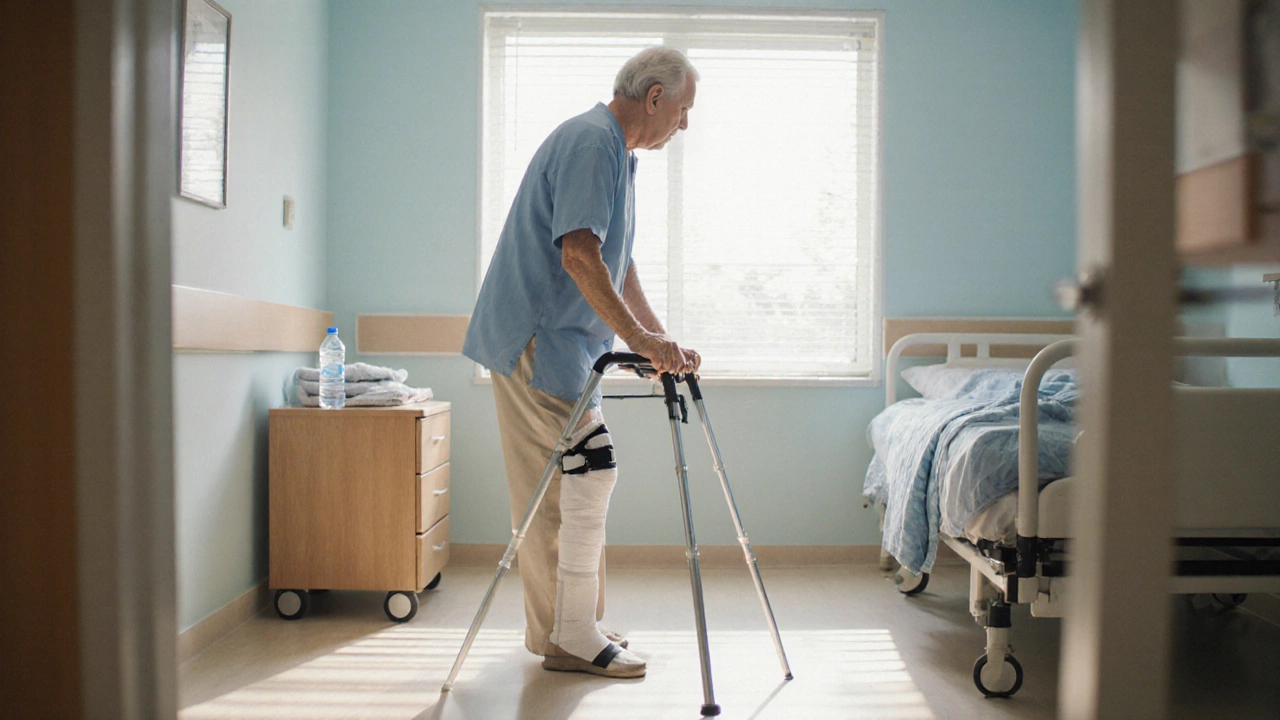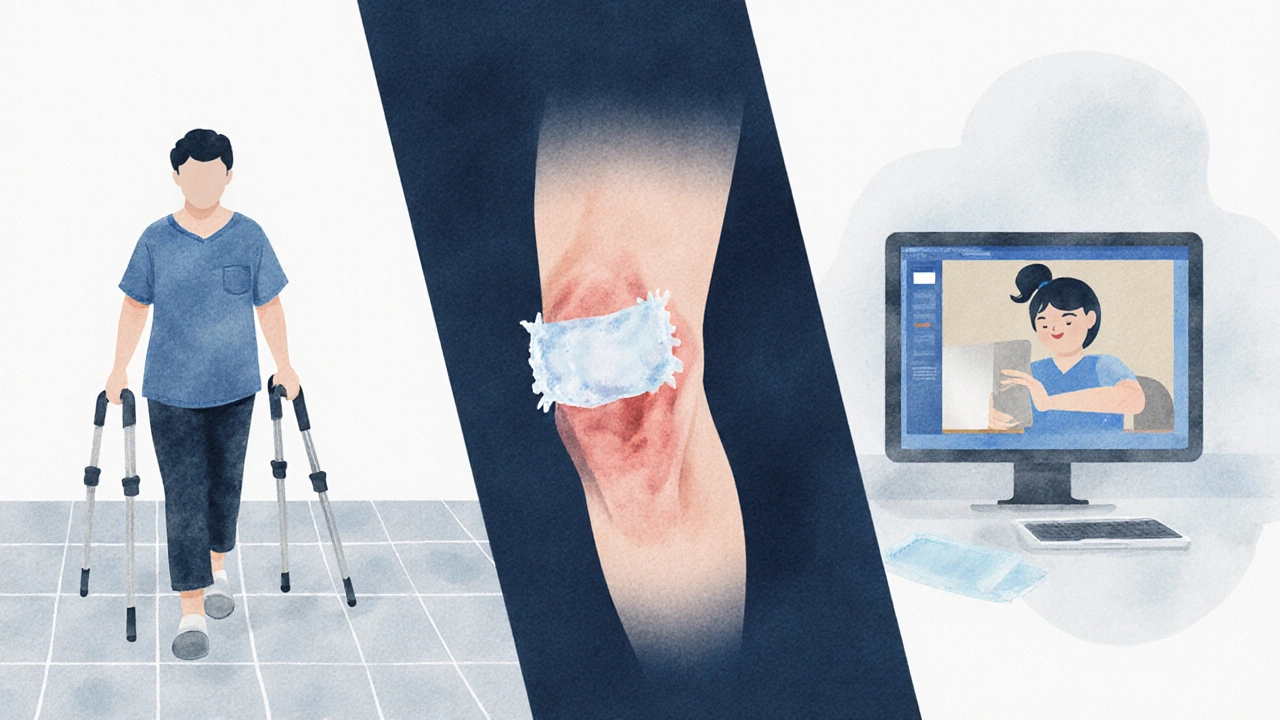
Knee Surgery Recovery Checklist
Daily Recovery Checklist
Common Mistakes vs Correct Actions
| Mistake | Correct Action | Benefit |
|---|---|---|
| Full weight-bearing immediately | Follow surgeon’s partial-weight protocol (e.g., 20% body weight for 2 weeks) | Protects repair, reduces risk of graft failure |
| Skipping therapy | Attend every scheduled PT session; do home exercises as prescribed | Restores range of motion and strength faster |
| Neglecting swelling control | Apply ice 15-20 min, 3-4×/day; use compression sleeves | Limits scar tissue, decreases pain |
| Over-reliance on pain meds | Use meds only as adjunct; focus on controlled movement | Prevents masking of warning signs |
| High-impact sports too early | Wait at least 6 months for activities like running or basketball | Reduces re-injury risk |
Recovery Benefits
Following these guidelines helps reduce the risk of complications, speeds healing, and ensures optimal long-term outcomes. Remember: consistency over intensity is key to successful recovery.
Recovering from Knee surgery is a surgical procedure that repairs or replaces structures within the knee joint, such as ligaments, meniscus, or cartilage isn’t just about the operation itself - it’s what you do (or don’t do) in the weeks that follow that makes the difference between a smooth comeback and a painful setback.
Key Takeaways
- Rushing weight‑bearing, ignoring swelling, and skipping therapy are the top three pitfalls.
- Follow a structured rehab plan; small daily goals beat big, infrequent effort.
- Listen to pain signals - they’re warning lights, not invitations to push harder.
- Proper use of ice, compression, and assistive devices speeds healing.
- When in doubt, call your surgeon or physical therapist before changing the plan.
Why Post‑Surgery Mistakes Happen
Many patients walk out of the operating theatre feeling relieved, then immediately want to return to their old routine. That eagerness, combined with mixed messages from friends, the internet, or even well‑meaning family, fuels common errors. Add to that the natural discomfort and the brain’s tendency to downplay pain, and you’ve got a recipe for poor choices.

Top 10 Mistakes and How to Fix Them
- Starting full weight‑bearing too early
Even if you feel fine, the repaired tissue still needs protection. Jumping straight to normal walking puts excessive stress on the sutures.
Use crutches or a walker as advised, and follow the surgeon’s timeline - usually "partial weight‑bearing" for 2‑4 weeks, then gradual increase.
- Skipping physical therapy sessions
Therapy isn’t a luxury; it’s the engine that restores range of motion and muscle strength.
Commit to every appointment. If you miss one, schedule a make‑up session within 48hours - the knee’s healing window is short.
- Ignoring swelling and pain
Swelling (or edema) and moderate pain are normal, but unchecked inflammation can lead to scar tissue and stiffness.
Apply the "RICE" protocol - Rest, Ice, Compression, Elevation - several times a day for the first week.
- Over‑relying on pain medication
Taking opioids or NSAIDs at the first sign of discomfort can mask warning signals, encouraging premature activity.
Use medication as a bridge, not a crutch. Combine low‑dose pain relief with controlled movement and ice.
- Skipping gentle stretching
Stiffness creeps in fast when the knee sits still. Even light stretching keeps the joint supple.
Do heel‑slides and quad sets 5‑10times each morning - they cost seconds but gain degrees of motion.
- Returning to high‑impact sports too soon
Running, jumping, or pivoting before the graft or repair is fully integrated can cause re‑tear.
Most surgeons recommend a 6‑month hiatus for high‑impact activities; low‑impact options (swimming, cycling) can begin earlier under guidance.
- Neglecting proper footwear
Worn‑out shoes or high heels shift load to the knee unevenly, hampering recovery.
Choose supportive, low‑heel shoes with good arch support for the first three months.
- Doing unsupervised home exercises
Copy‑pasting a YouTube video without professional oversight can lead to improper form, stressing the joint.
Ask your therapist for a printable routine and review it in a follow‑up session.
- Missing follow‑up appointments
Surgeons monitor healing via X‑rays or physical checks. Skipping these visits leaves complications undetected.
Mark every post‑op appointment on your calendar; treat it like a medication dose.
- Ignoring signs of infection
Redness, warmth, fever, or foul‑smelling drainage are red flags.
Contact your surgeon immediately if any appear - early antibiotics can save the joint.
Simple Checklist to Keep You on Track
- Follow weight‑bearing instructions exactly.
- Attend every physical therapy session.
- Apply ice for 15‑20minutes, 3‑4 times daily (first 2 weeks).
- Use compression wraps and elevate the leg above heart level when resting.
- Perform prescribed stretching and strengthening exercises twice a day.
- Wear supportive shoes; avoid high heels or worn soles.
- Log pain levels; if pain spikes >5/10, pause activity and call your therapist.
- Keep follow‑up appointments; note any changes in swelling or wound appearance.
- Know infection signs: increasing redness, warmth, fever >38°C, or drainage.
When to Seek Professional Help
Even with the best plan, the body can surprise you. Call your surgeon or physical therapist if you notice any of the following:
- Sharp, localized pain that doesn’t improve with rest.
- Swelling that worsens after the first week despite icing.
- Visible wound opening, pus, or foul odor.
- Loss of ability to straighten or bend the knee beyond 10 degrees.
Early intervention reduces the chance of long‑term damage and may prevent a second surgery.

Comparison Table: Mistake vs Correct Action
| Mistake | Correct Action | Benefit |
|---|---|---|
| Full weight‑bearing immediately | Follow surgeon’s partial‑weight protocol (e.g., 20% body weight for 2weeks) | Protects repair, reduces risk of graft failure |
| Skipping therapy | Attend every scheduled PT session; do home exercises as prescribed | Restores range of motion and strength faster |
| Neglecting swelling control | Apply ice 15‑20min, 3‑4×/day; use compression sleeves | Limits scar tissue, decreases pain |
| Over‑reliance on pain meds | Use meds only as adjunct; focus on controlled movement | Prevents masking of warning signs |
| High‑impact sports too early | Wait at least 6months for activities like running or basketball | Reduces re‑injury risk |
Final Thoughts
Recovering from knee surgery is a marathon, not a sprint. The most common knee surgery mistakes boil down to three themes: moving too fast, ignoring the body’s signals, and skipping professional guidance. Stick to the rehab plan, respect pain, and stay connected with your care team, and you’ll give your knee the best chance to heal fully.
Frequently Asked Questions
How soon can I start walking after knee surgery?
Most surgeons recommend using crutches and bearing only a small fraction of your body weight for the first 1‑2weeks. Full weight‑bearing typically begins around week3‑4, but follow the specific timeline given by your surgeon.
Is it normal to feel pain three weeks after surgery?
Mild to moderate pain is common up to 4‑6weeks, especially after therapy sessions. Sharp, escalating pain or pain that wakes you at night warrants a call to your surgeon.
Can I use a stationary bike during rehab?
A low‑resistance stationary bike is often introduced around week3‑4 to improve range of motion without impact. Your therapist will set the exact resistance level.
What are signs of a knee infection?
Look for increasing redness, warmth, swelling, foul‑smelling drainage, or a fever above 38°C. Contact your surgeon immediately if any appear.
How long does it take to return to normal activities?
Low‑impact activities often resume by 8‑12weeks, while high‑impact sports may need 6‑9months. Recovery time varies with the type of surgery and individual healing rates.
Categories
Popular Articles

Mar 10 2025

Jan 31 2025



